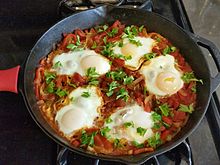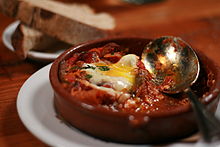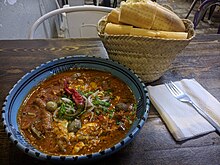This is an old revision of this page, as edited by 85.255.232.86 (talk) at 05:58, 19 October 2024 (Mention in specific the origins. Tunisian culture shouldn’t generalised and watered down as north african or attributed to ottomans.This doesn’t take place with moroccan,algerian and libyan heritage. Sufficient evidence that’s from Tunes and should rightfully attributed to its country of origins. :)). The present address (URL) is a permanent link to this revision, which may differ significantly from the current revision.
Revision as of 05:58, 19 October 2024 by 85.255.232.86 (talk) (Mention in specific the origins. Tunisian culture shouldn’t generalised and watered down as north african or attributed to ottomans.This doesn’t take place with moroccan,algerian and libyan heritage. Sufficient evidence that’s from Tunes and should rightfully attributed to its country of origins. :))(diff) ← Previous revision | Latest revision (diff) | Newer revision → (diff) Maghrebi dish of eggs poached in a sauce For the shredded flatbread and chickpea dish, see Chakhchoukha. For the Turkish eggplant dish, see Şakşuka. For the documentary film, see The Shakshuka System. Shakshouka in a cast iron pan Shakshouka in a cast iron pan | |
| Alternative names | Shakshuka, chakchouka |
|---|---|
| Type | Main dish |
| Place of origin | Ottoman North Africa |
| Main ingredients | Tomatoes, harissa, eggs, olive oil |

Shakshouka (Template:Lang-ar : šakšūkah, also spelled shakshuka or chakchouka) is a Tunisian dish of eggs poached in a sauce of tomatoes, olive oil, peppers, onion, and garlic, commonly spiced with cumin, paprika and cayenne pepper. Shakshouka is a popular dish throughout North Africa and the Middle East.
Etymology
Shakshuka is a word for "mixture" in Algerian Arabic and "mixed" in Tunisian Arabic. The Oxford English Dictionary describes it as being of multiple origins, an onomatopoeic Maghribi Arabic word, related to the verb shakshaka meaning "to bubble, to sizzle, to be mixed up, to be beaten together," and the French word Chakchouka, which was borrowed into English in the nineteenth century. Chakchouka was borrowed into French from Algerian Arabic.
History
Gil Marks, while noting some similarities with the Ottoman dish menemen, suggests that shakshouka evolved from şakşuka which spread to the Maghreb through the influence of the Ottoman Empire. Anthony Buccini noted similarities between a wider range of vegetable stews. He and Noam Sienna conclude that both shakshouka and menemen, among other dishes like piperade and ratatouille, are members of a wider family of vegetable stews of common ancestry appearing throughout the western Mediterranean.
The migration of Maghrebi Jews in the 1950s brought the dish to Israel, where it was subsequently widely adopted despite not being previously present in Palestinian or Levantine cuisine. Shakshouka began appearing in Israeli restaurants in the 1990s.
Variations


Many variations of the basic sauce are possible, varying in spice and sweetness. Some cooks add preserved lemon, salty sheep milk cheeses, olives, harissa or a spicy sausage such as chorizo or merguez. Shakshouka is made with eggs, which are commonly poached but can also be scrambled, like in the Turkish menemen.
In Algeria, shakshouka is commonly eaten as a side dish, and there are countless variations of it, each with their own unique blend of ingredients. One such variation is hmiss, which is often served alongside traditional kesra bread. Hmiss typically includes grilled peppers, tomatoes, and garlic. In Tunisia, a similar dish called slata meshouia is enjoyed, but it differs from hmiss with the addition of onions, cumin and tuna.
Some variations of shakshouka can be made with lamb mince, toasted whole spices, yogurt and fresh herbs. Spices can include ground coriander, caraway, paprika, cumin and cayenne pepper. Tunisian cooks may add potatoes, broad beans, artichoke hearts or courgettes to the dish. The North African dish matbukha can be used as a base for shakshouka.
Because eggs are the main ingredient, it often appears on breakfast menus in English-speaking countries, but in the Arab world as well as Israel, it is also a popular evening meal, and like hummus and falafel, is a Levantine regional favorite. On the side, pickled vegetables and North African sausage called merguez might be served, or simply bread, with mint tea.
In Jewish culture, a large batch of tomato stew is made for the Sabbath dinner and the leftovers used the following morning to make a breakfast shakshouka with eggs. In Andalusian cuisine, the dish is known as huevos a la flamenca; this version includes chorizo and serrano ham. In Italian cuisine, there is a version of this dish called uova in purgatorio (eggs in purgatory) that adds garlic, basil or parsley.
Vegan variants replace the eggs with tofu.
See also
References
- "What is Shakshuka?". embassies.gov.il. Retrieved 2024-10-19.
- Karadsheh, Suzy (2022-03-18). "Best Shakshuka Recipe (Easy & Authentic)". The Mediterranean Dish. Retrieved 2024-10-19.
- R.D, Bill Bradley (2016-10-31). "Shakshuka (Eggs Poached in Spicy Tomato Sauce - Morocco)". Mediterranean Living. Retrieved 2024-10-19.
- Salah, Maha (14 February 2020). "Shakshuka". Middle East Monitor.
- بن قينة، عمر (2010). قوة الحق فوق حق القوة. دار الأمة،. p. 121. ISBN 978-9961-67-199-3.
- "shakshuka". Collins English Dictionary.
- "shakshuka". Oxford English Dictionary.
- Alain Rey (2011). Dictionnaire Historique de la langue française. NATHAN, 2011. p. 4220. ISBN 2-321-00013-9.
- ^ Gil Marks (2010). Encyclopedia of Jewish Food. HMH. p. 1673. ISBN 978-0-544-18631-6.
- ^ Sienna, Noam (2021). "Shakshūka for All Seasons: Tunisian Jewish Foodways at the Turn of the Twentieth Century". In Gaul, Anny; Pitts, Graham Auman; Valosik, Vicki (eds.). Making Levantine Cuisine: Modern Foodways of the Eastern Mediterranean. University of Texas Press. pp. 170–183. doi:10.7560/324578. ISBN 978-1-4773-2457-8. JSTOR 10.7560/324578.
- Buccini, Anthony F. (2006). "Western Mediterranean Vegetable Stews and the Integration of Culinary Exotica". In Hosking, Richard (ed.). Authenticity in the Kitchen: Proceedings of the Oxford Symposium on Food and Cookery 2005. Prospect Books. pp. 132–145.
- Fitzgerald, Mary (Apr 24, 2021). "Shakshuka: All mixed up over a brilliant breakfast". The Irish Times. Retrieved 2021-09-09.
- "Shakshuka recipe". The Guardian. February 18, 2012.
- Joel Lurie Grishaver (2008). Artzeinu: An Israel Encounter.
- ^ Gil Marks, Encyclopedia of Jewish Food, Houghton Mifflin Harcourt, 2010, ISBN 9780470391303, s.v., p. 547
- Gordon, Peter (2018-06-03). "Peter Gordon's lamb shakshouka recipe". The Guardian. ISSN 0261-3077. Retrieved 2018-07-21.
- "Shakshouka Recipe – Tunisian Recipes". PBS Food. 2015-03-12. Retrieved 2018-07-21.
- Clark, Melissa. "Shakshuka With Feta Recipe". NYT Cooking. Retrieved 2018-07-21.
- Roden, Claudia (1996). The Book of Jewish Food: An Odyssey from Samarkand to New York. Knopf. p. 512. ISBN 9780394532585.
- Gur, Janna (2014). Jewish Soul Food: From Minsk to Marrakesh.
- Clifford-Smith, Stephanie (2011-06-07). "Three of a kind ... shakshouka". Sydney Morning Herald. Archived from the original on 2017-08-08. Retrieved 2017-08-07.
- Josephs, Bernard (2009-10-08). "Shakshuka: Israel's hottest breakfast dish". The Jewish Chronicle. Archived from the original on 2017-08-08. Retrieved 2017-08-07.
- Ashkenazi, Michael (2020). Food Cultures of Israel: Recipes, Customs, and Issues. p. 89.
- Tish, Ben (2019). Moorish: Vibrant Recipes from the Mediterranean. Bloomsbury. p. 46. ISBN 9781472958082.
- "Uova in purgatorio". La Cucina italiana (in Italian). 20 August 2015. Retrieved 2023-06-24.
- "Tofu 'Shakshuka'". Washington Post. Retrieved 2024-06-29.
External links
 Quotations related to Shakshouka at Wikiquote
Quotations related to Shakshouka at Wikiquote
| Cuisine of Tunisia | |
|---|---|
| Breads, dishes, and soups | |
| Ingredients | |
| Beverages | |
| Desserts and pastries | |
| Related | |
| Algerian cuisine | |
|---|---|
| Dishes | |
| Soups | |
| Brochettes | |
| Ingredients | |
| Beverages | |
| Desserts and pastries | |
| Related | |
| Jewish cuisine | |||||||||||
|---|---|---|---|---|---|---|---|---|---|---|---|
| History | |||||||||||
| Types | |||||||||||
| Religious dietary laws and related terms | |||||||||||
| Chefs | |||||||||||
| Religious foods | |||||||||||
| Breads |
| ||||||||||
| Sweets |
| ||||||||||
| Pastries | |||||||||||
| Fried foods |
| ||||||||||
| Dumplings, pastas and grain dishes |
| ||||||||||
| Casseroles and savory baked dishes | |||||||||||
| Snacks and other baked goods | |||||||||||
| Sandwiches | |||||||||||
| Egg dishes | |||||||||||
| Meat dishes | |||||||||||
| Fish dishes | |||||||||||
| Salads and pickles | |||||||||||
| Vegetable dishes | |||||||||||
| Soups and stews | |||||||||||
| Cheeses and other dairy products | |||||||||||
| Condiments, dips and sauces | |||||||||||
| Beverages | |||||||||||
| Herbs, spices and seasonings | |||||||||||
| Eateries | |||||||||||
| Related lists | |||||||||||
| Moroccan cuisine | |
|---|---|
| Dishes (list) | |
| Brochettes | |
| Ingredients | |
| Soups | |
| Breads | |
| Desserts & pastries | |
| Beverages | |
| Related cuisines | |
- Arab cuisine
- Libyan cuisine
- Tunisian cuisine
- Algerian cuisine
- Moroccan cuisine
- Israeli cuisine
- Egyptian cuisine
- Yemeni cuisine
- Egg dishes
- National dishes
- Mizrahi Jewish cuisine
- Sephardi Jewish cuisine
- Maghrebi cuisine
- Ottoman cuisine
- Spanish cuisine
- Italian cuisine
- Meze
- Tomato dishes
- Breakfast
- Transatlantic cultural exchange
- Shabbat food
- Middle Eastern cuisine
- Berber cuisine
- Romani cuisine
- Palestinian cuisine